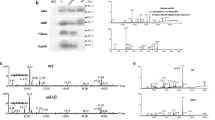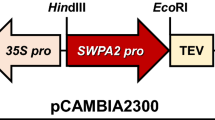Abstract
The cytochrome P450 2E1 (CYP2E1) enzyme encoded by CYP2E1 plays an important role in the metabolism of organic compounds in mammalian liver cells. In this study, the plasmid pCAMBIA2300 harboring the rabbit CYP2E1 was transferred into Agrobacterium tumefaciens; this was then transferred into internodes of Ardisia pusilla. Shoot primordia, whose appearance resembles that of the in vitro protocorm-like body of orchids, regenerated from 121 of 332 internodes that were cultured in selection medium supplemented with 5 mg·L−1 kanamycin. PCR analysis confirmed that 25 of 89 putative transgenic plants (28.0%) stably harbored the CYP2E1 and NPTII genes, and Southern blot analysis revealed the presence of one to three copies of CYP2E1 within the genome of the 25 transgenic plants. The mRNA expression of the transgene was confirmed in 12 of 25 CYP2E1-transgenic plants by Northern blot analysis. Western blot analysis indicated the presence of a 53-kDa recombinant rabbit CYP2E1 protein in the 12 CYP2E1-transgenic A. pusilla plants. The aniline 4-hydroxylase activity of rabbit CYP2E1 in nine CYP2E1-transgenic A. pusilla plants was higher than that in non-transgenic A. pusilla plants. There was a statistically significant increase (5.1–6.1-fold) in the toluene removal ability of the transgenic line CYP2E1-2–2 compared to that observed in wild-type Ardisia plants at different times after exogenous toluene exposure.








Similar content being viewed by others
Change history
14 April 2021
A Correction to this paper has been published: https://doi.org/10.1007/s13580-021-00356-9
References
Abhilash PC, Jamil S, Singh N (2009) Transgenic plants for enhanced biodegradation and phytoremediation of organic xenobiotics. Biotechnol Adv 27:474–488
Ahn CH, Kim NS, Shin JY, Lee YA, Kim KJ, Kim JH, Park PM, An HR, Kim YJ, Kim WH, Lee SY (2020) Enhanced detoxification of exogenous toluene gas in transgenic Ardisia pusilla expressing AtNDPK2 gene. Hortic Environ Biotechnol 61:949–957
Balestrazzi A, Botti S, Zelasco S, Biondi S, Franchin C, Calligari P, Racchi M, Turchi A, Lingua G, Berta G, Carbonera D (2009) Expression of the PsMTA1 gene in white poplar engineered with the MAT system is associated with heavy metal tolerance and 6srotection against 8-hydroxy-2ʹ-deoxyguanosine mediated-DNA damage. Plant Cell Rep 28:1179–1192
Banerjee S, Shang TQ, Wilson AM, Moore AL, Strand SE, Gordon MP, Doty SL (2002) Expression of functional mammalian P450 2E1 in hairy root cultures. Biotechnol Bioeng 77:462–466
Butaye K, Cammue B, Delaure S, De Bolle M (2005) Approaches to minimize variation of transgene expression in plants. Mol Breed 16:79–91
Doty SL, James CA, Moore AL, Vajzovic A, Singleton GL, Ma C, Khan Z, Xin G, Kang JW, Park JY, Meilan R, Strauss SH, Wilkerson J, Farin F, Strand SE (2007) Enhanced phytoremediation of volatile environmental pollutants with transgenic trees. Proc Natl Acad Sci 23:16816–16821
Doty SL (2008) Enhancing phytoremediation through the use of the transgenics and endophytes. New Phytol 179:318–333
Doty SL, Shang TQ, Wilson AM, Tangen J, Westergreen AD, Newman LA, Strand SE, Gordon MP (2000) Enhanced metabolism of halogenated hydrocarbons in transgenic plants containing mammalian cytochrome P450 2E1. Proc Natl Acad Sci 97:6287–6291
Doyle JJ, Dickson EE (1987) Preservation of plant samples for DNA restriction endonuclease analysis. Taxon 36:715–772
Gonzalez FJ (2007) The 2006 bernard b. Brodie award lecture. Cyp2e1. Drug Metab Dispos 35:1–8
James CA, Xin G, Doty SL, Strand SE (2008) Degradation of low molecular weight volatile organic compounds by plants genetically modified with mammalian cytochrome P450 2E1. Environ Sci Technol 42:289–293
Jones HD (2005) Wheat transformation: Current technology and applications to grain development and composition. J Cereal Sci 41:137–141
Kim YJ, Han B, Kim HJ, Jang SK, Lee WS (2006) Performance test of air cleaners: Deionization of ammonia, acetic acid and acetaldehyde and gas removal of toluene and formaldehyde. J Kor Soc Indoor Environ 3:236–246
Kim KJ, Jeong MI, Lee DW, Song JS, Kim HD, Yoo EH, Jeong SJ, Han SW, Kays SJ, Lim YW, Kim HH (2010) Variation in formaldehyde removal efficiency among indoor plant species. HortSci 45:1489–1495
Kim KJ, Yoo EH, Jeong MI, Song JS, Lee SY, Kays SJ (2011) Changes phytoremediation potential of indoor plants with exposure to toluene. HortSci 46:1646–1649
Kim KJ, Yoo EH, Kays SJ (2012) Decay kinetics of toluene phytoremediation stimulation. HortSci 47:1195–1198
Kumar S, Fladung M (2001) Controlling transgene integration in plants. Trends Plant Sci 6:155–159
Laemmli UK (1970) Cleavage of structural proteins during the assembly of the head bacteriophage T4. Nature 227:196–685
Lee SS, Buters JT, Pineau T, Fernandez-Salguero P, Gonzalez FJ (1996) Role of CYP2E1 in the hepatotoxicity of acetaminophen. J Biol Chem 271:12063–12067
Lee SY, Lee JL, Kim JH, Kim KJ (2015) Enhanced removal of exogenous formaldehyde gas by AtFALDH-transgenic petunia. Hortic Environ Biotechnol 56:247–254
Lee SY, Kim YS, Han GH (2008) Shoot regeneration from internode sections of Ardisia pusilla DC. J Plant Biotechnol 35:209–231
Ministry of Food, Agriculture, Forestry and Fisheries (MFAFF) 2004. 2003 status of cultivation in flower crops. MFAFF (ed), Korea, p 5 (in Korean)
Ministry of Food, Agriculture, Forestry and Fisheries (MFAFF) 2020. 2019 status of cultivation in flower crops. MFAFF (ed), Korea, p 18 (in Korean)
Murashige T, Skoog F (1962) A revised medium for rapid growth and bioassay with tobacco tissue cultures. Physiol Plant 15:473–497
Sambrook J, Russell DW (2001) Molecular cloning: a laboratory manual (3-volume set), vol 999. Cold spring harbor laboratory press, Cold Spring Harbor, New York
Sandermann HJ (1994) Higher plant metabolism of xenobiotics: the “green liver” concept. Pharmacogenetics 4:225–241
Win-Shwe T, Fujimaki H (2010) Neurotoxicity of toluene Toxico Lett 198:93–99
Yao Q, Cong L, Chang JL, Li KX, Yang GX, He GY (2006) Low copy number gene transfer and stable expression in a commercial wheat cultivar via particle bombardment. J Exp Bot 57:3737–3746
Youssef AF, Baggs RB, Weiss B, Miller RK, Pahan K, Smith BT, Singh AK, Singh I (1997) Cytochrome P-450 2E1 in rat liver peroxisomes-downregulation by ischemia/reperfusion-induced oxidative stress. Free Radic Biol Med 23:963–971
Zhang D, Xiang T, Li P, Bao L (2011) Transgenic plants of Petunia hybrida harboring the CYP2E1 gene efficiently remove benzene and toluene pollutants and improve resistance to formaldehyde. Genet Mol Biol 34:634–639
Zhang L, Routsong R, Strand SE (2019) Greatly enhanced removal of volatile organic carcinogens by a genetically modified houseplant, Pothos Ivy (Epipremnum aureum) expressing the mammalian cytochrome P450 2e1 gene. Environ Sci Technol 53:325–331
Acknowledgements
This study was supported by a grant from the Next-Generation BioGreen 21 Program (No. PJ01319803), Rural Development Administration, South Korea.
Author information
Authors and Affiliations
Contributions
Su Young Lee and Ju Young Shin obtained CYP2E1-transgenic Ardisia plants. YA Lee performed PCR analysis. Jeong Ho Kim performed Southern and Northern blot analyses. Nan-Sun Kim performed Western blot analysis and CYP2E1 activity assays. Kwang Jin Kim performed the experiment to measure the removal ability of exogenous toluene gas, and others (Hye Ryun An, Pil Man park, and Pue Hee Park) statistically analyzed the data.
Corresponding author
Ethics declarations
Conflict of interest
The authors declare that they have no conflicts of interest.
Additional information
Communicated by Tae-Ho Han, Ph.D.
Publisher's Note
Springer Nature remains neutral with regard to jurisdictional claims in published maps and institutional affiliations.
The original online version of this article was revised: The spelling of Su Young Lee’s name was incorrect.
Rights and permissions
About this article
Cite this article
Kim, NS., Shin, J.Y., Lee, Y.A. et al. Exogenous toluene gas removal improvement in recombinant rabbit cytochrome P450 2E1 (CYP2E1)-transgenic Ardisia pusilla DC. Hortic. Environ. Biotechnol. 62, 619–627 (2021). https://doi.org/10.1007/s13580-021-00333-2
Received:
Revised:
Accepted:
Published:
Issue Date:
DOI: https://doi.org/10.1007/s13580-021-00333-2




